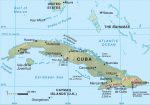Cuba Looks Ahead
Admirers of Cuba often call this island nation the “Pearl of the Antilles” because of its beautiful natural and cultural landscapes and its potential riches. In the modern world, Cuba should be a center of trade and wealth. The sad reality is that Cuba has never enjoyed true political independence, and it has degenerated into […]
Living in Cuba Today
Havana is Cuba's dominant urban center, with one in four city dwellers living there. This Caribbean metropolis is a primate city, which means that Havana is huge in comparison to the size of the next largest city. Indeed, its metropolitan population of about 3.7 million is several times larger than Santiago de Cuba, Cuba's second […]
Cuba’s Economy
The Castro government transformed the Cuban economy from capitalism to Marxist-Leninist Socialism. The main element of Marxist-Leninist Socialism is the governments “nationalization of all means of production.” This phrase means that the government takes over ownership of all farms, factories, warehouses, railroads, banks, and so on. The government also sets all prices, wages, and salaries […]
Government and Politics
Spain did not create political units on Cuba until 1827. In that year, the Spanish began to govern the island through three loosely defined departments: Occidental (Western), Central (Central), and Oriente (Eastern). The departments were under the command of a captain general who lived in Havana. Each department had several towns. The towns had broad […]
People and Culture
Cuba has the largest population among Caribbean countries, nearly 11.5 million inhabitants. The island's population is highly urbanized, with 76 percent of the people living in cities. With so many people in cities, rural areas are sparsely settled. Like two poles of a magnet, Cuba's population is concentrated on opposite ends of the island. Thirty-eight […]
Cuba Through Time
The Siboney and Guanahatabey Indians are the earliest known inhabitants of Cuba. They arrived there sometime after 3500 b.c. Both groups lived in small temporary settlements. Their dwellings were concentrated near the ocean, because sea life was their main source of food. They gathered clams, mussels, crabs, and lobsters; hunted manatees and sea turtles; and […]

Physical Landscapes
Although we often speak of Cuba as one island, Cuba is actually an archipelago, or group of islands, whose total combined area is 42,803 square miles (110,860 square kilometers). Cuba is the largest island in this archipelago, making up 95 percent of the total land area of the island group. The second largest island, Isla […]

Introducing Cuba
Cuba is an alligator-shaped island and the largest country in the Caribbean Sea. It is located just south of the Tropic of Cancer (23 1/2° north latitude). Florida lies just 90 miles (145 kilometers) to the north and the Yucatan Peninsula of Mexico is to the west. Cuba is one of the Caribbean region's Greater […]

Cuba
Area 68,885 square mi (110,860 square km) Population 11.26 million 2014 Capital Havana Highest Point 6,578 ft (2,005 m) Lowest Point 0 m GDP $77.15 billion 2013 Primary Natural Resources sugar, tobacco, citrus, coffee, rice. CUBA, THE 15th largest island in world, is part of the West Indies in the CARIBBEAN SEA. This island, which […]